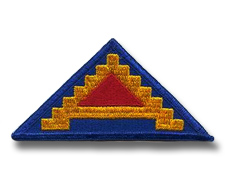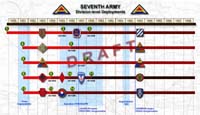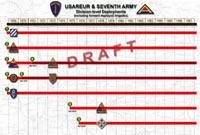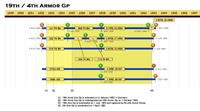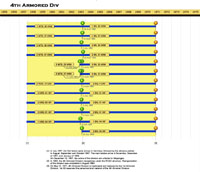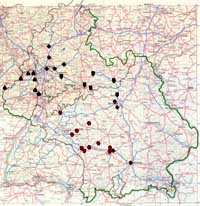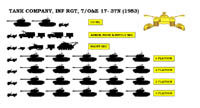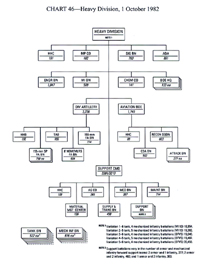|
Combat
Divisions in the European Theater |
|||||||||||||||||||||||||||||||||||||||||||||||||||||||||||||||||||||||||||||||||
|
|
|||||||||||||||||||||||||||||||||||||||||||||||||||||||||||||||||||||||||||||||||
|
|||||||||||||||||||||||||||||||||||||||||||||||||||||||||||||||||||||||||||||||||
|
|
|||||||||||||||||||||||||||||||||||||||||||||||||||||||||||||||||||||||||||||||||
| US Army Divisions in Germany (1945-1989) | |||||||||||||||||||||||||||||||||||||||||||||||||||||||||||||||||||||||||||||||||
| 1950 - 1989 | |||||||||||||||||||||||||||||||||||||||||||||||||||||||||||||||||||||||||||||||||
|
|||||||||||||||||||||||||||||||||||||||||||||||||||||||||||||||||||||||||||||||||
|
|
|||||||||||||||||||||||||||||||||||||||||||||||||||||||||||||||||||||||||||||||||
| Reflagging ARMORED & CAVALRY Units | |||||||||||||||||||||||||||||||||||||||||||||||||||||||||||||||||||||||||||||||||
| (Source: Maneuver and Firepower: The Evolution of Divisions and Separate Brigades, by John B. Wilson, Army Lineage Series, 1998; Armor-Cavalry, Part I, by Mary Lee Stubbs and Stanley Russell Connor, Army Lineage Series, 1969; Infantry, Part I, by John K. Mahon and Romana Danysh, Army Lineage Series, 1972; Sixty Years of Reorganizing for Combat: A Historical Trend Analysis, CSI Report No. 14, January 2000.) | |||||||||||||||||||||||||||||||||||||||||||||||||||||||||||||||||||||||||||||||||
| The scope of this particular reflagging study is limited to armor, cavalry, field artillery, and infantry units. (Divisional and non-divisional artillery units will be detailed on the Overview Page of the Field Artillery section.) | |||||||||||||||||||||||||||||||||||||||||||||||||||||||||||||||||||||||||||||||||
|
|||||||||||||||||||||||||||||||||||||||||||||||||||||||||||||||||||||||||||||||||
|
|||||||||||||||||||||||||||||||||||||||||||||||||||||||||||||||||||||||||||||||||
|
|||||||||||||||||||||||||||||||||||||||||||||||||||||||||||||||||||||||||||||||||
|
|||||||||||||||||||||||||||||||||||||||||||||||||||||||||||||||||||||||||||||||||
|
|||||||||||||||||||||||||||||||||||||||||||||||||||||||||||||||||||||||||||||||||
|
|||||||||||||||||||||||||||||||||||||||||||||||||||||||||||||||||||||||||||||||||
|
|||||||||||||||||||||||||||||||||||||||||||||||||||||||||||||||||||||||||||||||||
|
|||||||||||||||||||||||||||||||||||||||||||||||||||||||||||||||||||||||||||||||||
| The Occupation Period (1945 to Augmentation, 1951) | |||||||||||||||||||||||||||||||||||||||||||||||||||||||||||||||||||||||||||||||||
|
|
|||||||||||||||||||||||||||||||||||||||||||||||||||||||||||||||||||||||||||||||||
| The 1950s (Augmentation and beyond) | |||||||||||||||||||||||||||||||||||||||||||||||||||||||||||||||||||||||||||||||||
| 1953 - 1963 | |||||||||||||||||||||||||||||||||||||||||||||||||||||||||||||||||||||||||||||||||
|
|||||||||||||||||||||||||||||||||||||||||||||||||||||||||||||||||||||||||||||||||
|
|
|||||||||||||||||||||||||||||||||||||||||||||||||||||||||||||||||||||||||||||||||
| (Source: Harald Spaeth) | |||||||||||||||||||||||||||||||||||||||||||||||||||||||||||||||||||||||||||||||||
| TANK COMPANY, INF REGT (1953) | |||||||||||||||||||||||||||||||||||||||||||||||||||||||||||||||||||||||||||||||||
|
|||||||||||||||||||||||||||||||||||||||||||||||||||||||||||||||||||||||||||||||||
|
|
|||||||||||||||||||||||||||||||||||||||||||||||||||||||||||||||||||||||||||||||||
| TOE 1948 - Armored and Infantry divisions arriving in Europe as part of the Korean War build-up: The first postwar TOE's for armored and infantry divisions were published between late 1947 and mid-1948. Based on these new tables, armored and infantry divisions were reorganized between the fall of 1948 and the end of 1949. Most divisions, however, never attained their table of organization strengths prior to the Korean War. Only the 1st Infantry Division in Germany was authorized at full strength. ARMD DIV 1948: three medium tank battalions; one heavy tank battalion; one reconnaissance battalion; four armored infantry battalions; three 105-mm FA battalions; one 155-mm FA Battalion. INF DIV 1948: three infantry regiments/three infantry battalions each; one tank battalion; one reconnaissance company; three 105-mm FA battalions; one 155-mm FA Battalion.) |
|||||||||||||||||||||||||||||||||||||||||||||||||||||||||||||||||||||||||||||||||
| Unit designation changes due to replacement of Army Reserve units by Regular Army units: The Department of the Army implemented a program in FY 1954 with the goal of returning all reserve component units (National Guard and Army Reserve) to the United States that had been activated as part of the Troop Augmentation program in the early 1950s and sent to Europe to build up the forces there. These units were approaching the statutory limitations for active federal service. All units released were replaced by Regular Army units of the same kind, with all changes made less personnel and equipment. See Return of Reserve/National Guard Units to US on the Seventh Army Page for more details. |
|||||||||||||||||||||||||||||||||||||||||||||||||||||||||||||||||||||||||||||||||
| Organizational changes due to Operation Gyroscope: See Operation Gyroscope in the US Army, Europe an online historical manuscript for more details. |
|||||||||||||||||||||||||||||||||||||||||||||||||||||||||||||||||||||||||||||||||
| Unit designation changes due to implementation of CARS (1957-58): See Questions and Answers about the Combat Arms Regimental System an online version of a publication issued by the Center of Military History in 1978. |
|||||||||||||||||||||||||||||||||||||||||||||||||||||||||||||||||||||||||||||||||
| PENTOMIC Force Structure | |||||||||||||||||||||||||||||||||||||||||||||||||||||||||||||||||||||||||||||||||
|
TOE changes due to implementation of Pentomic Structure (1957-59): Regular Army infantry and armored divisions were reorganized under the "Pentomic" structure, completed by 1957? or 1960. The European Command also retained an airborne capability by reorganizing two battle groups in the 24th Inf Div as airbone units. As the Army reorganized (Pentomic divisions) and shuffled divisions (Gyroscope) around the world, it adopted the Combat Arms Regimental System for infantry, artillery, cavalry, and armor. ARMD DIV 1960: 4 tank battalions (90-mm); 1 reconnaissance battalion; 4 armored infantry battalions; 3 105-mm FA battalions; 1 Gen Spt FA Battalion. INF DIV 1960: 5 battle groups; 1 tank battalion; 1 reconnaissance squadron; 3 105-mm FA battalions; 1 105-mm/155-mm FA Battalion; 1 Composite FA Battalion. ADDITIONAL INFORMATION (Source: Jim Chorazy) As part of either Pentomic structure implementation and/or CARS, there was a change effective I believe on 1 Oct 1957 in which in the ARMD DIVs (1) the AIB’s became ARB’s (Armored Rifle Bns) and the applicable Tk Bns became known as “MTB’s” or Medium Tank Battalions -- I guess they could still be called by generic names such as the above 1960 ARMD DIV scheme showing “4 tank battalions” & “4 armored infantry battalions”. -- of course, when ROAD occurred in 1963 the ARBs became MIBs & the MTBs became simply Bns. For example, in ROAD, 1st Medium Tank Bn, 33rd Armor at Gelnhausen became “1st Bn, 33rd Armor”. |
|||||||||||||||||||||||||||||||||||||||||||||||||||||||||||||||||||||||||||||||||
| (Source: The United States Army in Europe 1953 - 1963, by D.J. Hickman, HQ USAREUR 1964) | |||||||||||||||||||||||||||||||||||||||||||||||||||||||||||||||||||||||||||||||||
| NEW CONCEPTS
IN TACTICAL ORGANIZATION Two major changes (Pentomic Division and ROAD) in Army tactical concepts significantly affected USAREUR's readiness posture occurred in the 1950s and 60s. Both developments increased the command's combat capability, and both coincided with changing U.S. military strategy. The Pentomic Division In the early 1950's, when overwhelming Soviet military forces faced the Western nations, U.S. Army planners decided that, if American ground forces were to hold the decisive margin of strength on the battlefield of the future, they would have to possess superior mobility and exploit the effects of weapons of greatly increased firepower. The firepower would come from atomic weapons; with these, superior tactical and logistical mobility could defeat a numerically superior enemy. This tactical concept was initiated in 1953 and 1954, when the first atomic delivery weapons arrived in Europe, and in early 1956, when one airborne and one armored division replaced two infantry divisions. (Webmaster Note: the 11th Airborne Division replaced the 5th Infantry Division in Augsburg (early 1956) and the 3rd Armored Division replaced the 4th Infantry Division in Frankfurt (May-June 1956).) In late 1956 the Department of the Army proposed a reorganization plan to adapt infantry, armored, and airborne divisions to atomic warfare. The plan -- labeled the Pentomic Concept -- was approved for Army-wide implementation, and in November 1956 USEUCOM set tentative dates for the reorganization of the Seventh Army divisions under that concept. The reorganization of the 11th Airborne Division into five major battle groups, completely air transportable, was completed by the end of April 1957. The other four divisions in Europe were reorganized during the following five months (the 2nd Armored Division and 10th Infantry Division by 1 July 1957; 8th Infantry Division by 1 August 1957 and the 3rd Armored Division by 1 Oct 1957). Under the pentomic organization the infantry division lost one 155-mm and two 105-mm howitzer battalions, but a single composite unit, consisting of one 8-inch howitzer, one Honest John, and two 155-mm howitzer batteries, was added to increase its firepower. The infantry division also lost its regimental tank company, but its reconnaissance company was replaced with an armored cavalry battalion. Each infantry division had more than 100 tanks. The armored divisions gained 261 personnel spaces, whereas the overall infantry division strength was reduced by 3,000. Frontline infantry elements, however, were increased by about 450 men. The spaces recovered in the strength reductions were used to meet troop ceiling reductions and to satisfy such new requirements as the establishment of a Redstone missile group and the augmentation of nuclear weapons logistical support units. The infantry and armored divisions lost one antiaircraft artillery battalion each. Complementing the divisional reorganization, six 90-mm antiaircraft artillery battalions were converted to Nike missile battalions, and USAREUR's Honest John batteries were reorganized into battalions. The end product conformed closely to the original concept. Although primarily designed for atomic warfare and often referred to as atomic divisions, the pentomic units were actually capable of fighting both a nuclear and a conventional war. ROAD reorganization in the early 1960s |
|||||||||||||||||||||||||||||||||||||||||||||||||||||||||||||||||||||||||||||||||
|
|
|||||||||||||||||||||||||||||||||||||||||||||||||||||||||||||||||||||||||||||||||
| The 1960s (Berlin Wall and Vietnam) | |||||||||||||||||||||||||||||||||||||||||||||||||||||||||||||||||||||||||||||||||
| ROAD Force Structure | |||||||||||||||||||||||||||||||||||||||||||||||||||||||||||||||||||||||||||||||||
|
Table changes due to implementation of ROAD Structure (1962-64): ARMD DIV ROAD - six tank and five mechanized infantry battalions; three 105-mm FA Battalions; 1 155-mm FA Bn (comp) MECH INF DIV ROAD - three tank and seven mechanized infantry battalions; three 105-mm FA Battalions; 1 155-mm FA Bn (comp) ROAD Reorganizations in Europe: In Germany, the airborne capability was moved from the 24th Inf Div, Augsburg, to the 8th Inf Div, Bad Kreuznach, with one Brigade containing all of the airborne assets. |
|||||||||||||||||||||||||||||||||||||||||||||||||||||||||||||||||||||||||||||||||
| (Source: STARS & STRIPES, Sept 24, 1961) | |||||||||||||||||||||||||||||||||||||||||||||||||||||||||||||||||||||||||||||||||
| USAREUR has announced that the three (pentomic) infantry divisions in 7th Army will be completely mechanized in the next several months. The rifle companies in the battle groups of the 3rd, 8th and 24th Inf Divisions will receive eighteen M113 armored personnel carriers to complete the mechanization. The engineer companies within the divisions will also be mechanized by the addition of ten armored personnel carriers each. The conversion to Mechanized Infantry Divisions will require an increase in personnel in 7th Army - about 3,000. |
|||||||||||||||||||||||||||||||||||||||||||||||||||||||||||||||||||||||||||||||||
| (Source: STARS & STRIPES, Sept 23, 1963) | |||||||||||||||||||||||||||||||||||||||||||||||||||||||||||||||||||||||||||||||||
| In an article describing the 3rd Infantry Division materiel readiness council and materiel readiness program, the article mentions that 3rd Inf Div has more than 3,800 vehicles assigned to it. | |||||||||||||||||||||||||||||||||||||||||||||||||||||||||||||||||||||||||||||||||
| (Source: The United States Army in Europe 1953 - 1963, by D.J. Hickman, HQ USAREUR 1964) | |||||||||||||||||||||||||||||||||||||||||||||||||||||||||||||||||||||||||||||||||
| continued
from the Pentomic Division The ROAD Division The organization of a combat division, however, could not be a static concept. Further innovations were inevitable to keep pace with changes in technology, operational requirements, and strategy. Although the pentomic divisions were effective combat units, experience as well as examination of the world situation and of military requirements disclosed areas in which significant improvements could be made. By the early 1960's world events focused attention on the fact that Army combat forces faced a wide range of possible situations. The emerging strategy was termed a "strategy of flexible response." It was felt that combat units would have to be tailored to meet specific situations, that their tactical mobility and firepower would have to be matched to the environment and to the enemy and that their organizational structure would have to reflect the increasing probability of limited conventional war. The outgrowth of this thinking was the new concept known as the Reorganization Objective Army Divisions (ROAD), designed for specific yet varying strategic and tactical requirements. There was no letup in the development of U.S. nuclear capability, but emphasis was placed on the requirements of limited war . |
|||||||||||||||||||||||||||||||||||||||||||||||||||||||||||||||||||||||||||||||||
|
|||||||||||||||||||||||||||||||||||||||||||||||||||||||||||||||||||||||||||||||||
| In 1961 USAREUR began to receive a series of newly developed equipment. In September Seventh Army units were issued the first shipments of the M-14 rifle that replaced, in a single weapon, the M-1 rifle, the carbine, the Browning automatic rifle, and the Thompson submachinegun. The new M60 main battle tank -- lighter, faster, and with a better weapons system and greater operational range than its predecessor -- was also issued. The new light and fast M113 armored personnel carriers proved to be vastly superior to the heavier obsolete vehicles they replaced. The shoulder-fired M79 grenade launcher filled the gap between the maximum range of a hand grenade and the minimum range of the mortar; the new series of self-propelled howitzers increased artillery mobility; and the revolutionary, nuclear-capable Davy Crockett gave the infantryman more firepower than he had ever had. In 1961 USAREUR began to receive a series of newly developed equipment. In September Seventh Army units were issued the first shipments of the M-14 rifle that replaced, in a single weapon, the M-1 rifle, the carbine, the Browning automatic rifle, and the Thompson submachinegun. The new M60 main battle tank -- lighter, faster, and with a better weapons system and greater operational range than its predecessor -- was also issued. The new light and fast M113 armored personnel carriers proved to be vastly superior to the heavier obsolete vehicles they replaced. The shoulder-fired M79 grenade launcher filled the gap between the maximum range of a hand grenade and the minimum range of the mortar; the new series of self-propelled howitzers increased artillery mobility; and the revolutionary, nuclear-capable Davy Crockett gave the infantryman more firepower than he had ever had. In 1962 these new items of equipment continued to arrive in Europe and underwent extensive tests in the hands of USAREUR troops. In addition, training began with the new French-designed Entac antitank missile, and Iroquois helicopters and Mohawk aircraft, necessary to support the aviation missions of ROAD divisions, began to arrive. In 1963 when the time came for converting divisions to the ROAD configuration, USAREUR was ready for a smooth and rapid transition that would not jeopardize its combat readiness. Practically all the necessary equipment was on hand, and most of it had been issued. Beginning in February, 60 days were allotted to each division for conversion, but most of the units converted in 30. Reorganization of the last division was accelerated by one month, so that all five divisions completed the transition by mid October 1963. The ROAD organization provided USAREUR with modern, flexible forces. Each of the new divisions consisted of a division base and a varying mixture of three types of combat maneuver battalions -- tank, mechanized infantry, and airborne; the fourth type -- straight infantry battalions -- was used only in Berlin. The base contained the elements required by all divisions: command and control; artillery; a support command; three brigade headquarters; and other necessary combat and combat support units, such as reconnaissance squadrons and aviation, signal, and engineer battalions. The general types of units making up the division base were identical, but their equipment, organization, and methods of operation varied with the type and mission of the division. Similarly, all battalions had a basic structure but were organized and equipped to provide combinations of mobility, firepower, and other combat capabilities that allowed their adaptation to combat tasks and environmental variables. The powerful tank battalion, with its heavy armor-protected mobility, firepower, and shock action, performed its traditional role. The mechanized infantry battalion -- the predominant unit in Seventh Army's infantry divisions -- was equipped with armored personnel carriers that provided lightweight, armor-protected, cross-country mobility; and both the infantry and the airborne battalions, though lighter, were adaptable to a wide range of environments and missions -- particularly those requiring movement by air -- and to employment in terrain where mechanized forces could not be used to best effect. In general, the reorganization gave USAREUR five divisions with protected tactical mobility suited to the European environment and more nearly matching the massive Soviet mechanized forces. The new structure also provided units that were more compatible with those of other NATO nations. |
|||||||||||||||||||||||||||||||||||||||||||||||||||||||||||||||||||||||||||||||||
|
TOE changes due to Vietnam War resource requirements: In the mid- and late-1960s, the Army's major effort was in Vietnam, and divisions in other commands supported that effort. Although the Army did not withdraw any divisions from Europe for service in Vietnam, USAREUR also contributed to the combat effort. In the 3rd, 8th, and 24th Infantry Divisions an armor battalion replaced a mechanized infantry battalion in 1966 (1). (MECH INF DIV - four armor and six mech infantry battalions.) In the artillery battalions of the armored and mech inf divisions SP 155-mm howitzers replaced the 105-mm pieces because the larger howitzers could fire both conventional and nuclear warheads and had a longer range. REFORGER - One division (less a brigade) and some smaller units was returned to the States in the first half of 1968 (3rd Bde, 24th Inf Div remained in Germany). April 1970, 3rd Bde, 24th Inf Div replaced by 3rd Bde, 1st Inf Div May 1971, 1st Armd Div replaced the 4th Armd Div (1) Addition of an armor battalion in USAREUR infantry divisions (1966):
(2) Studying USAREUR station lists from the period, it appears that 2nd Bn, 19th Inf in Gablingen was inactivated sometime in 1965 and 5th Bn, 32nd Armor assigned to the 24th Inf Div in the same time frame. |
|||||||||||||||||||||||||||||||||||||||||||||||||||||||||||||||||||||||||||||||||
|
|
|||||||||||||||||||||||||||||||||||||||||||||||||||||||||||||||||||||||||||||||||
| The 1970s and 1980s | |||||||||||||||||||||||||||||||||||||||||||||||||||||||||||||||||||||||||||||||||
| TOE changes in 1970: New divisional tables were published in 1970, Honest John rocket battalions were eliminated as divisional units, and new LANCE missile units replaced them at corps level. An additional armor battalion was added to the mechanized infantry division, making the mix five armor and six mechanized infantry battalions. Subsequently, the Army activated additional armor battalions for the 3rd and 8th Infantry Divisions in Germany in 1972 (1). In the armored division the maneuver mix remained at five mechanized infantry and six armor battalions. 1974 Organizations: (1) 8th Infantry Division -- 4th Bn, 69th Arm was activated in Sept 1972 at Lee Barracks, Mainz. 3rd Infantry Division -- |
|||||||||||||||||||||||||||||||||||||||||||||||||||||||||||||||||||||||||||||||||
| "H" Series Table of Organization & Equipment | |||||||||||||||||||||||||||||||||||||||||||||||||||||||||||||||||||||||||||||||||
| (Source: STARS & STRIPES, Dec 28, 1971) | |||||||||||||||||||||||||||||||||||||||||||||||||||||||||||||||||||||||||||||||||
| Changes due to implementation of the "H" Series TOE (1972): It was announced in late 1971, that 1st Inf Div (FWD) and 3rd Inf Div would undergo some organizational changes in the spring of 1972 as part of a program to realign all active Army units under the new "H" series TOE. The changes would not change the overall strength of the divisions. However, costs would be reduced through standardization of equipment and personnel authorizations. More effective maintenance and administrative support would lead to further costs savings. Most noticieable changes: 1) A Combat Support Company is added to the mechanized infantry and tank battalions. 2) The Data Processing Company in the Division Support Command will be combined with the division headquarters and headquarters company. 3) A separate Finance Company will be formed. 4) A Heavy Equipment Company will be added to the division Maintenance Battalion. 5) The division air defense capability will be enhanced through an increase in the number of Redeye firing teams. 6) A new division Aviation Company will be formed by merging aviation assets from the division heaquarters and headquarters company with those form the Supply & Transportation Battalion. |
|||||||||||||||||||||||||||||||||||||||||||||||||||||||||||||||||||||||||||||||||
| Organizational changes caused by the Nunn Amendment: Brigade 75 Brigade 76 2nd Armd Div supported the rotation of Brigade 75; 3rd Bde deployed to Germany between March-June 1975; the brigade was a mechanized infantry brigade; in the fall of 1978 (?), the Army assigned the brigade permanently to USAREUR (page 367) 4th Inf Div supported the rotation of Brigade 76; 4th Bde deployed to Germany in 1976; the brigade was a mechanized infantry brigade; in the fall of 1976, the Army assigned the brigade permanently to USAREUR |
|||||||||||||||||||||||||||||||||||||||||||||||||||||||||||||||||||||||||||||||||
| Division-86 Force Structure | |||||||||||||||||||||||||||||||||||||||||||||||||||||||||||||||||||||||||||||||||
| TOE changes due to implementation of Division-86: Due to a shortfall of personnel, the Army inactivated the 4th Bde, 4th Inf Div in Europe in 1984 to provide the manpower spaces required for modernizing the forces in Germany. Also decided at this time was the adoption of a new regimental system (ARS) in which each armor, air defense artillery, cavary, field artillery, and infantry regiment was assigned a home base from which regimental elements would rotate between continental and overseas assignments. Later aviation and SF regiments were added to this system. (The unit rotation concept was abandoned because of personnel turbulence and its advers effect on unit readiness.) Heavy Armd Div - six armor and four mech inf battalions; Heavy Mech Inf Div - five armor and five mech inf battalions; |
|||||||||||||||||||||||||||||||||||||||||||||||||||||||||||||||||||||||||||||||||
| (Source: Maneuver and Firepower, The Evolution of Divisions and Separate Brigades. By John B. Wilson, Center of Military History, US Army, 1998) | |||||||||||||||||||||||||||||||||||||||||||||||||||||||||||||||||||||||||||||||||
| Analysis of combat
within the framework of the AirLand Battle
concept, published in 1982 (FM 100-5, Operations),
led to the development of the Division-86
force structure. Because of the importance of Europe to national security,
Division-86 emphasized a standardized heavy division, which combined
both armored and mechanized infantry divisions, and focused on maximizing
the new equipment entering the inventory. The Division-86 proposal retained the flexible ROAD structure. The new heavy division (totaling about 20,000 officers and enlisted men) consisted of: |
|||||||||||||||||||||||||||||||||||||||||||||||||||||||||||||||||||||||||||||||||
| The Training
and Doctrine Command published tables of organization and equipment
for this second try at the heavy division concept on 1 October 1982
(Chart 46). One set of tables covered both the mechanized infantry
division and the armored division, but with five variations. Five
or six armor and four or five mechanized infantry battalions were
to be assigned to an armored division, and a mechanized infantry division
was to have five armor and five mechanized infantry battalions. Variations
in the tables also covered different equipment, M60 tanks and M113
armored personnel carriers or the new M1 Abrams tanks and Bradley
infantry fighting vehicles. Given the variations, the strength of
heavy divisions ranged between 19,000 and 20,500 officers and enlisted
men. The published tables differed somewhat from the proposed heavy division that Meyer had approved three years earlier. Cavalry fighting vehicles replaced tanks in the reconnaissance squadron, and the squadron, consisting of two ground and two air troops, had no motorcycles. Rather than being a divisional unit, it was a part of the aviation brigade. The finance unit moved to the corps level, and the reorganized military intelligence battalion fielded electronic warfare, surveillance, and service companies. In the support command, the medical battalion reappeared, but the chemical company was returned to divisional level, and the target acquisition element was reduced to a battery. The Army faced complex problems in fielding Division-86. Over forty major weapons or new pieces of equipment needed to be procured, and some were still in developmental stages. Doctrinal literature and training programs required revision, and budgetary limitations had to be considered. The solution approved by the Army Staff, as in the past, was to adopt the heavy division concept but with interim organizations using obsolete equipment until new weapons and equipment were available. Delivery of many new items was expected to begin in 1983. Therefore, organizational and equipment modernization was to begin in January of that year. The number of maneuver elements for a heavy armored division was set at six armor and four mechanized infantry battalions, while that for a heavy mechanized infantry division was placed at five armor and five mechanized infantry battalions. The Army also faced another problem in fielding the new heavy division, a shortfall in personnel. The Training and Doctrine Command estimated that a strength of 836,000 was required to field Army-86, but only 780,000 was authorized for the foreseeable future. Therefore to provide manpower spaces for modernizing the forces in Germany, the 4th Brigade, 4th Infantry Division, was inactivated in Europe in 1984 along with other units throughout the Army. Shortly thereafter the modernization plan went awry. Because of various problems involved in funding and procuring equipment, the Army leadership slipped the completion date for modernizing heavy divisions to the mid-1990s. US Army Regimental System Early in the planning process for modernizing divisional forces, (General Edward C.) Meyer also decided to adopt a new regimental system. It was to address one aspect of the "hollow Army" (the problem of having sufficient personnel and equipment to support and sustain the forward-deployed Army), unit cohesion. Patterned after the Combat Arms Regimental System (CARS), the new United States Army Regimental System assigned each armor, air defense artillery, cavalry, field artillery, and infantry regiment -- later aviation regiments and special forces were added -- a home base from which regimental elements would rotate between continental and overseas assignments. A soldier could affiliate with a regiment and expect to serve in it for most of his or her career. By necessity the new system broke traditional regimental associations with divisions since fewer regiments could be accommodated in the system because of the linking of elements between overseas and continental stations. Meyer believed that the benefits of unit cohesion outweighed the loss of divisional affiliation. He tied implementation of the new regimental system to modernization of the force. By 1985 implementation of the regimental system was separated from force modernization because of production delays, and unit rotation was abandoned because of personnel turbulence and its adverse effect on readiness. Nevertheless, designating regiments as part of the system continued, paced by the number of flags that the U.S. Army Support Activity, Philadelphia, could manufacture each month. The flags were needed when the battalion designations were changed. |
|||||||||||||||||||||||||||||||||||||||||||||||||||||||||||||||||||||||||||||||||
|
|
|||||||||||||||||||||||||||||||||||||||||||||||||||||||||||||||||||||||||||||||||
| Major Organizational Changes under DIV-86 | |||||||||||||||||||||||||||||||||||||||||||||||||||||||||||||||||||||||||||||||||
| DIVISION
SUPPORT COMMAND Under the "come-as-you-are, fight-as-you-are" approach to war, combat service support had to be immediately available in the battle area. To meet the new logistical requirements, Division-86 called for a radical reorganization of the division support command, primarily to address the forward area of the battlefield. The command included a materiel management center, adjutant general and finance companies, a supply and transport battalion, a maintenance battalion, and three support battalions, one for each divisional brigade. Support battalions, which were to "arm, fuel, fix, and feed forward," included headquarters and headquarters, supply, maintenance, and medical companies. A small medical battalion supported the rest of the division. Planners had difficulty deciding whether to place a chemical company at corps, division, or division support command level, but gave it to the supply and transport battalion in the support command. MANEUVER UNITS Each tank battalion consisted of a headquarters element and four tank companies, and each tank company fielded three platoons of four tanks each. Mechanized infantry battalions contained a headquarters element along with one TOW and four rifle companies, with the riflemen to be mounted on new Bradley infantry fighting vehicles. To counter the Soviet Union's high density of artillery and improved weapons, the Division-86 study, like its predecessor, significantly increased the division artillery. It fielded three battalions of 155-mm. self-propelled howitzers organized into three batteries, each having eight pieces; one battalion of sixteen 8-inch howitzers and nine multiple launch rocket systems (MLRS) mounted on vehicles; and a target acquisition battalion. AIR CAVALRY ATTACK BRIGADE (later designated as the AVIATION BRIGADE) A new organization, an air cavalry attack brigade (later designated as an aviation brigade), which resulted from the pioneer work of the 1st Cavalry Division and the 6th Cavalry Brigade at Fort Hood and others, appeared in the division to provide helicopters for an antitank role. Two attack battalions, each consisting of four companies with six helicopters each, and a combat support aviation battalion, which provided resources for command aviation, aircraft maintenance, and the reconnaissance squadron, made up the brigade. The brigade fielded 134 aircraft. The reconnaissance squadron called for four troops -- two ground and two air troops. Each of the ground troops haved two platoons equipped with cavalry fighting vehicles -- similar to the Bradley fighting vehicle. |
|||||||||||||||||||||||||||||||||||||||||||||||||||||||||||||||||||||||||||||||||
|
|
|||||||||||||||||||||||||||||||||||||||||||||||||||||||||||||||||||||||||||||||||
| Division-86 Reorganizations in Germany | |||||||||||||||||||||||||||||||||||||||||||||||||||||||||||||||||||||||||||||||||
| 1st
Armored Division 2nd Armored Division (Fwd) 3rd Armored Division 1st Infantry Division (Fwd) 3rd Infantry Division (M) 8th Infantry Division (M) |
|||||||||||||||||||||||||||||||||||||||||||||||||||||||||||||||||||||||||||||||||
| Army of Excellence | |||||||||||||||||||||||||||||||||||||||||||||||||||||||||||||||||||||||||||||||||
| TOE changes due to implementation of Army of Excellence: 1989 Organizations: |
|||||||||||||||||||||||||||||||||||||||||||||||||||||||||||||||||||||||||||||||||
|
|
|||||||||||||||||||||||||||||||||||||||||||||||||||||||||||||||||||||||||||||||||
| Related Links: |
|||||||||||||||||||||||||||||||||||||||||||||||||||||||||||||||||||||||||||||||||
